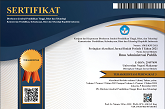An Analysis of the Effectiveness of Allocation of Village Fund Policy Implementation and Its Determining Factors in Gorontalo Regency
(1) Universitas Negeri Gorontalo
(*) Corresponding Author
DOI: https://doi.org/10.26858/jiap.v9i2.10947
Abstract
Keywords
Full Text:
PDFReferences
Abidin, M. Z. (2015). Tinjauan atas pelaksanaan keuangan desa dalam mendukung kebijakan dana desa. Jurnal Ekonomi Dan Kebijakan Publik, 6(1), 61–76.
Hehamahua, H. (2015). Impact Analysis of the Village Fund Allocation (ADD) Toward Economic Community (Case Study on the Rural District of Namlea Siahoni), Buru Regency. Journal of Social and Development Sciences, 6(3), 15–23.
Keban, Y. T. (2014). Enam Dimensi Strategis Administrasi Publik Edisi 3. Yogyakarta: Gava Media.
Miles, M. B., Huberman, A. M., & Saldaña, J. (2014). Qualitative data analysis: A methods sourcebook. 3rd. Thousand Oaks, CA: Sage.
Moleong, J. (2014). Metodologi Penelitian kualitatif. Bandung: PT. Remaja Rosdakarya bandung.
Nawir, R., Maulana, R., Nuryamin, M., & Husain, T. (2018). Implementation Program of Poor Rice Copyright. The International Conference On Social Sciences And Humanities 2018.
Prasetyo, Y., & Masdjojo, G. N. (2015). Implementasi Kebijakan Alokasi Dana Desa di 10 Desa Wilayah Kecamatan Rembang Kabupaten Rembang.
Purwanto, A., & Sulistiyastuti. (2012). Implementasi Kebijakan Publik: Konsep dan Aplikasinya di Indonesia. Yogyakarta: Gaya Media.
Sulila, I. (2019). The Effect of Human Resource Competency and Implementation of SIMDA on the Quality of Financial Statement at BPKAD Office of Gorontalo City. Publik (Jurnal Ilmu Administrasi), 8(1), 67–74.
Syamsiar, S., Saggaf, M. S., Salam, R., & Ihsan, S. R. (2018). Implementation Of Supervision On Office Of Community Empowerment And Makassar City Village. The International Conference On Social Sciences And Humanities 2018.
Uphoff, N. T., Cohen, J. M., & Goldsmith, A. A. (1979). Feasibility and application of rural development participation: a state-of-the-art paper.
Warsono, H., & Ruksamin, D. (2014). The Obstacles of Implementation of Village Allocation Fund Program in the North Konawe Southeast Sulawesi. J. Mgmt. & Sustainability, 4, 175.
Article Metrics
Abstract view : 950 times | PDF view : 168 timesRefbacks
- There are currently no refbacks.
Copyright (c) 2019 ismet sulila

This work is licensed under a Creative Commons Attribution 4.0 International License.
Diterbitkan oleh:
Program Studi Ilmu Administrasi Publik
Program Pascasarjana Universitas Negeri Makassar
JIAP Index By:

This work is licensed under a Creative Commons Attribution 4.0 International License.









